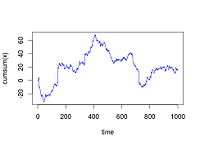Seven states of randomness

Okay kiddo, let me explain the seven states of randomness in a way you can understand. Imagine you have a big bowl filled with colorful candies. If you close your eyes and pick up a candy without looking, you never know which one you will get. That's like randomness because it's unpredictable and there's no pattern to it.
Now, let's say you shake the bowl and mix up the candies. The candies are still random, but now they're also chaotic. It's like when you and your friends are playing tag, and you're all running around in different directions. There's no plan, and things can get pretty crazy!
The next state of randomness is called "orderly." This is when things start to form patterns. Maybe all the red candies are on one side of the bowl, and all the blue ones are on the other side. It's still random because you don't know which color you'll pick, but it's not as chaotic as before.
The fourth state is "predictable," which means you can start to make guesses about what will happen. Maybe you notice that every other candy is green, or that there are exactly 10 red candies in the bowl. You can't be 100% sure, but you have a good idea of what might happen next.
As we move onto the fifth and sixth states, things get even more predictable. In the fifth state, called "deterministic," every candy has a specific place in the bowl. You know exactly where each candy is, and you can even make predictions about what will happen when you shake the bowl.
The final state of randomness is "algorithmic." This means that everything is so predictable and follows such a strict set of rules that you can program a computer to do it for you. It's like a game where you always know how to win because you've memorized all the moves.
So, that's the seven states of randomness: unpredictable, chaotic, orderly, predictable, deterministic, and algorithmic. Each state has its own level of randomness and predictability, and it's cool to think about how we can use these states to understand the world around us!
Now, let's say you shake the bowl and mix up the candies. The candies are still random, but now they're also chaotic. It's like when you and your friends are playing tag, and you're all running around in different directions. There's no plan, and things can get pretty crazy!
The next state of randomness is called "orderly." This is when things start to form patterns. Maybe all the red candies are on one side of the bowl, and all the blue ones are on the other side. It's still random because you don't know which color you'll pick, but it's not as chaotic as before.
The fourth state is "predictable," which means you can start to make guesses about what will happen. Maybe you notice that every other candy is green, or that there are exactly 10 red candies in the bowl. You can't be 100% sure, but you have a good idea of what might happen next.
As we move onto the fifth and sixth states, things get even more predictable. In the fifth state, called "deterministic," every candy has a specific place in the bowl. You know exactly where each candy is, and you can even make predictions about what will happen when you shake the bowl.
The final state of randomness is "algorithmic." This means that everything is so predictable and follows such a strict set of rules that you can program a computer to do it for you. It's like a game where you always know how to win because you've memorized all the moves.
So, that's the seven states of randomness: unpredictable, chaotic, orderly, predictable, deterministic, and algorithmic. Each state has its own level of randomness and predictability, and it's cool to think about how we can use these states to understand the world around us!
Related topics others have asked about:
